Disinfection Building at Auschwitz-Birkenau
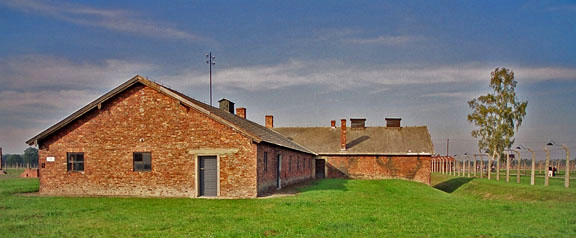
Building where clothing
was deloused in Birkenau
There are two buildings located on the
south side of the Birkenau camp, which were used to delouse the
prisoners' clothing with Zyklon-B, the same gas that was used
to kill the Jews in the gas chambers. The two buildings are shaped
like the letter T and are mirror images of each other. The photo
above shows building BW5b which is located in the B1b section
of Birkenau on the left side of the camp as you are standing
at the entrance gate into the camp. The east wing of the building
above was used for delousing.
The second delousing building is BW5a
in the B1a section, which is on the other side of the fence on
the right in the photo above. The west wing of the BW5a building
was used for delousing. Both of these brick buildings also had
shower rooms for the prisoners.
On the blueprints of these buildings,
the delousing room was called a Gaskammer which means gas chamber
in English.
In November 2008, some blueprints of
the Birkenau disinfection buildings were found in an apartment
in Berlin, as reported in this news story. The blueprints are shown in the
photos below.
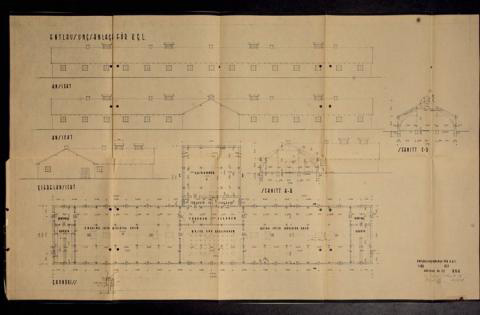 Blueprint of a Disinfection
Building at Birkenau
Blueprint of a Disinfection
Building at Birkenau
 Detail of blueprint
shows "Gaskammer" marked # 1
Detail of blueprint
shows "Gaskammer" marked # 1
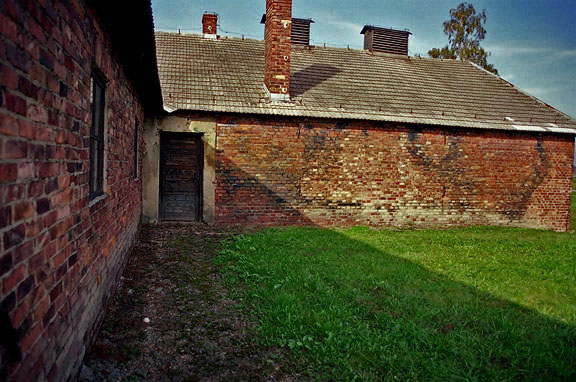
Blue stains on the
right were made by Zyklon-B
The photo above shows the blue stains
on the east wing of the BW5a building. These stains, called "Prussian
Blue," were the result of heavy use of Zyklon-B. The stains
on the outside were made by placing disinfected mattresses against
the wall. Both of the disinfection buildings at Birkenau had
a chamber that used Zyklon-B and also a hot air apparatus which
was used to kill lice. On the blueprint of the building, the
disinfection chamber was labeled "Gaskammer," which
is the German word for gas chamber.
The photo below shows a close-up of the
door in the building shown in the photo above.
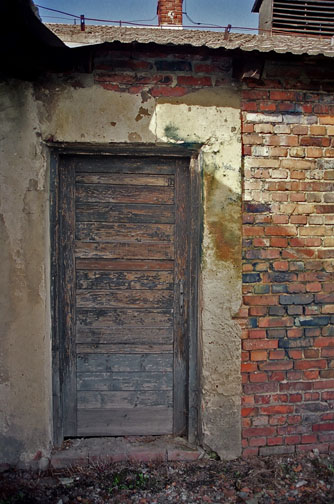 Blue stains near door
of disinfection building
Blue stains near door
of disinfection building
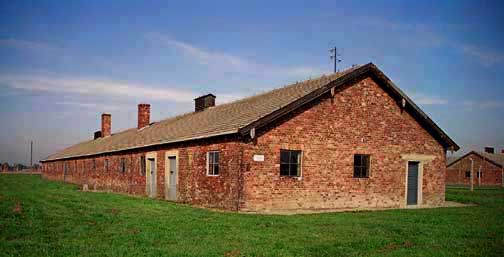
One of two buildings
at Birkenau used to delouse clothing
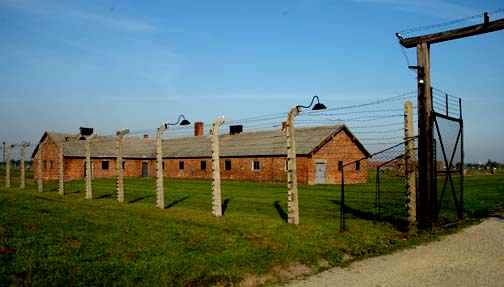
Disinfection building
in B1a section of Birkenau camp
The photo above shows a gate into sections
B1a and B1b which are on either side of a road that bisects the
entire camp, going from here all the way to the Mexico section
on the north side of the camp. The photo below shows a slogan
on an interior wall of the building shown above.

Sign painted on interior
wall of disinfection building
The sign on the wall inside one of the
disinfection buildings reads "Eine Laus dein Tod,"
which means "One louse your death." The photo of the
slogan on the wall was taken by holding a camera with a telephoto
lens against the glass of a window near the door of the building,
shown at the top of this page. Through another window, I could
see standing water inside the building.
The two disinfection buildings at Birkenau
were not open to visitors when I visited Birkenau in October
2005; a sign on the door of one of the buildings said "Conservation
Works."
In July 1942, a typhus epidemic got started
at Birkenau when lice were brought into the camp by civilian
workers. Three hundred inmates were dying each day before it
could be brought under control. In November 1942, disinfection
began in these two brick buildings in the women's camp in an
attempt to stop the epidemic.
According to Gerald Reitlinger who wrote
a book entitled "The Final Solution," the head of the
concentration camps, Reichsführer-SS Heinrich Himmler, issued
an order on December 28, 1942 which stated:
"The death rate in the camps
must be reduced at all costs."
The delousing of the clothing was a continuous
operation, according to Franciszek Piper, the director of the
Auschwitz Museum. After the clothing was hung up in the delousing
chamber, Zyklon-B pellets were put on the floor and left for
a period of 24 hours before the doors were opened. In contrast,
the gassing of the Jews took only 20 minutes, according to Piper.
There were no cremation ovens at Birkenau
until 1943 when Krema II, Krema III, Krema IV and Krema V were
completed and put into operation. The bodies of the prisoners
who died in the epidemic in 1942 were buried in mass graves;
they had to be dug up later and burned because the ground water
was becoming contaminated.
In December 1942, there were 19 Degesch
fumigation chambers, which were designed to use Zyklon-B, installed
in the Administration building in the main Auschwitz camp, which
is now the Visitor's Center. According to Rudolf Hoess, the first
Commandant of the Auschwitz-Birkenau camp, the disinfection chambers
at the Auschwitz main camp were also used for gassing the Jews
on one occassion in 1944. In his autobiography entitled "Death
Dealer," Hoes wrote the following on page 364:
After the destruction of the Hungarian
Jews and the Jews from the Lodz ghetto, it was decided that the
sonderkommando who had worked burning the bodies in the ovens
of the crematory and during the open-pit cremations should themselves
be killed in order to destroy the only witnesses who were in
a position to tell what happened. About two hundred of the Sonderkommando
were transferred to the main camp at Auschwitz, where they were
gassed in the chamber used to disinfect clothing.
Krema I in the main camp was used to
burn corpses in the main camp until 1943 when the cremation ovens
at Birkenau were put into operation. The bodies of the Sonderkommando
prisoners who were gassed in the main camp in 1944 were burned
in Krema I, according to Holocaust historian Danuta Czech.
In the Summer of 1943, the Zyklon-B equipment
in building BW5a was removed and two small hot air chambers were
put in. The photo below, taken in the Central Sauna, shows what
the hot air chambers looked like.
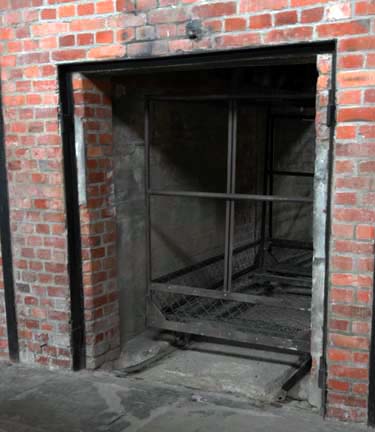 Hot air chamber for
delousing clothes
Hot air chamber for
delousing clothes
This page was last updated on June 2,
2009
|